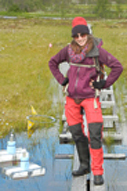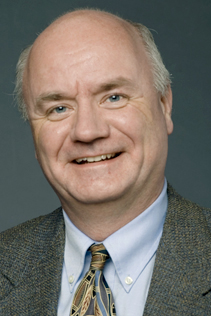Spring 2014
In late March at the Oceans and Human Health Grantees Meeting at the Scripps Institution of Oceanography, Tim Moore presented a first-year summary of toxic algae bloom work he and colleagues are conducting on Lake Erie under a National of Institutes of Health three-year grant. Moore also presented two posters at the Ocean Sciences Meeting in Honolulu in February—one on a project looking into the environmental controls of coccolithophore (a type of phytoplankton) blooms, the other an education/outreach poster on a collaboration with former OPAL outreach coordinator Amy Holt Cline. And Moore, as lead author, also published a manuscript on blending ocean color algorithms in lakes and coastal waters in Remote Sensing of Environment.
 |
|
| Linda Kalnejais | |
 |
|
| Joe Salisbury |
Linda Kalnejais co-chaired a session at the Ocean Sciences Meeting in Honolulu titled “Benthic-pelagic coupling and exchange across the sediment-water interface.”
Tom Gregory and Joe Salisbury report that OPAL scientists will soon deploy the Great Bay Coastal Buoy for its tenth season of ecosystem monitoring in the Gulf of Maine and New Hampshire's Great Bay. New sensors on the buoy are being used to study the effects of ocean acidification on coastal ecosystems. The work is a critical component of region-wide efforts by a host of scientists to monitor the health of coastal waters under changing environmental conditions.
Chris Hunt published a paper in Estuaries and Coasts titled “CO2 Input Dynamics and Air–Sea Exchange in a Large New England Estuary.” Surveys of the Kennebec estuary, the largest river estuary in the Gulf of Maine, showed releases of carbon dioxide to the atmosphere on an annual basis. CO2 in the Kennebec estuary came mostly from the Androscoggin and Kennebec rivers, instead of from within the estuary itself, as is the case in other regions. Joe Salisbury and Doug Vandemark are coauthors on the paper.
 |
|
| Shawn Shellito, right, with colleagues aboard the R/V Roger Revelle. |
In December, Shawn Shellito participated in an Air-Sea Interaction Research Initiative cruise on the Bay of Bengal with U.S. Naval Research Laboratory Oceanography Division, Woods Hole Oceanographic Institute, Scripps, Oregon State University and UNH scientists aboard the R/V Roger Revelle, a research vessel operated by Scripps as part of the University-National Oceanographic Laboratory System. The work's long-term objective is to better understand how the relatively fresh waters of the Bay of Bengal mix with highly saline inflow from the Arabian Sea. This mixing is thought to affect monsoon variability, climate, ocean circulation, and biological processes. In collaboration with Amala Mahadevan and Melissa Omand of Woods Hole, UNH principal investigator Joe Salisbury will use the data to understand the role of mixed layer optical properties on net heating, community productivity, and the cycling of carbon dioxide. Shellito operated the UNH optical package and kept a continuous atmospheric and surface carbon dioxide system operating while helping with shipboard conductivity, temperature and depth profiles. An important part of the cruise, Shellito notes, will be continued collaboration with Sri Lankan and Indian colleagues in an effort to share data and results.
 |
|
| Peter Bloser |
Peter Bloser received funding from the NASA Astrophysics Research and Analysis program. The project, an innovative collaboration with the UNH materials science program, will investigate if it would be possible to channel soft gamma rays using thin-film multilayer structures. “If so, we could possibly create a ‘lens’ to channel gamma rays from a large collecting area to a small, shielded detector, greatly improving the sensitivity for spectroscopy and polarimetry,” says Bloser. The project also involves Mark McConnell, and Jason Legere of the SSC, and James Krzanowski, Olof Echt, and John Tsavalas of materials science.
 |
|
| Kristoff Paulson |
Ph.D. student Kristoff Paulson had the paper "In situ observations of Pc1 pearl pulsations by the Van Allen Probes" accepted for publication in the Van Allen Probes special issue of Geophysical Research Letters. The pulsations are a form of time-modulated electromagnetic wave often seen by ground-based observatories but only rarely measured with spacecraft. The paper presents a catalog of these events observed in the first year of operations of the Van Allen Probes and provides data to discredit a previously held generation mechanism.
UNH undergraduate Molly Goelzer, a chemical engineering student, published two papers in the Journal of Geophysical Research. Charles Smith and Nathan Schwadron are co-authors. The papers applied a theory for the evolution of the interplanetary magnetic field with the solar cycle. The first compares those predictions with the historical record derived from a radioactive isotope of beryllium, and the second examines the variability of the Alfven radius, the point where the wind flows faster than the speed of low-frequency magnetic waves. The latter is expected to be of use to the Solar Probe Plus mission, in which EOS scientists are participating.
Ph.D. student Alexander Boyd was awarded an Outstanding Student Paper at the American Geophysical Union Fall Meeting in December. The title was “Using Phase Space Density Profiles to Investigate the Radiation Belt Seed Population.” Boyd has been studying the Earth's radiation belts, which are regions that contain high-energy "killer" electrons that can damage satellites flying through the region. Understanding where these electrons come from is one main goals of the current Van Allen Probes mission. “Using data from the Van Allen Probes, I showed that a group of lower energy electrons, known as the ‘seed population,’ play a critical role in producing those higher energy electrons.”
 | |
| Jason Shuster |
Ph.D. student Jason Shuster was awarded an Outstanding Student Paper at the AGU Fall Meeting for his poster presentation "Plasma Energization in Asymmetric Magnetic Reconnection at the Dayside Magnetopause During Magnetic Storms." Shuster studies plasmas in Earth's magnetosphere and their interaction with the sun's solar wind plasma. His research goal is to understand the explosive process of magnetic reconnection, a fundamental energy conversion mechanism of plasma physics that is capable of transporting solar wind plasma into the Earth's magnetosphere, which in turn can give rise to aurora.
 |
|
| Jichun Zhang |
Former visiting scholar Ruilin Lin and research scientist Jichun Zhang published a paper in the Journal of Geophysical Research Space Physics titled "Testing linear theory of EMIC waves in the inner magnetosphere: Cluster observations." The research was supported by Zhang’s NASA Electromagnetic Ion Cyclotron Wave grant. Lynn Kistler and Christopher Mouikis are coauthors on the paper.
Zhang gave an invited seminar talk at the Center for Atmospheric Research, University of Massachusetts, Lowell on Feb. 21 titled “EMIC waves and associated plasma conditions.”
Michael Palace, principal investigator, and several ESRC colleagues have been funded by NASA’s Interdisciplinary Research in Earth Science program on a project titled “Drought-induced vegetation change and fire in Amazonian forests: past, present, and future.” The work will provide a comprehensive assessment of forest resilience and vulnerability to drought using interdisciplinary methodologies such as the integration of multi-scale remotely sensed, eco-physiological, and paleoecological measurements. Co-investigators on the three-year, $1.8 million project include Heidi Asbjornsen, Steve Frolking, former ESRC faculty Michael Keller, Rob Braswell, and research scientist Steve Hagen, and former postdoc researcher Crystal McMichael.
Palace also has co-authored five papers published since the beginning of 2014 in Nature, Proceedings of the Royal Society B., Biotropica, Nature Communications, and the Journal of Biogeography.
 | |
| Sophia Burke |
Sophia Burke, a recent graduate from UNH's Environmental Science program, has received the Malmberg Scholarship from the American Swedish Institute to support her continued work at Stordalen Mire in Abisko, Sweden as part of the Northern Ecosystems Research for Undergraduates program (NERU). She will be spending four months at the location measuring emissions of methane from the mire landscape. Burke was a Research Experience for Undergraduates (REU) student of Ruth Varner's in the first year of NERU, which Varner directs, and served as Varner’s research assistant for the program last year. Burke hopes to start her Ph.D. at UNH in the fall using the NERU research as the foundation.
 |
|
| Danielle Grogan |
NRESS Ph.D. Student Danielle Grogan has been awarded a summer research fellowship to study in Japan under the National Science Foundation’s East Asia and Pacific Summer Institutes for U.S. Graduate Students program. The Japan Society for the Promotion of Science jointly sponsors the fellowship. Grogan will spend 10 weeks working with researchers at the University of Tokyo’s Global Hydrology and Water Resources Engineering Lab, which is directed by world-renowned hydrologist Taikan Oki. She will use two existing hydrologic models–UNH’s Water Balance Model and the University of Tokyo’s Catchment-based Macro-scale Floodplain model—to address a set of research questions: How does changing land use from forest to agriculture alter flood risks? How does this compare to flood risks due to urbanization? How will climate change increase or alleviate these risks? The fellowship grew out of Grogan’s involvement in an NSF-funded project led by Steve Frolking titled “Crops, Climate, Canals, and the Cryosphere in Asia; Changing Water Resources Around the Earth’s Third Pole,” which is part of NSF’s Water Sustainability and Climate program. Changsheng Li, Richard Lammers, and Dominik Wisser are also on the project.
Frolking and Lammers, through a collaboration in “Third Pole” project, have become involved in a Department of Energy-funded project led by Stanford and Penn State universities. One goal of the project is to improve the representation of water cycle and water resource economics in Integrated Assessment Modeling, which integrates a variety of inputs for different disciplines.
Frolking was a coauthor on a recent Nature Communications paper titled “Size and frequency of natural forest disturbances and the Amazon forest carbon balance” led by former ESRC Ph.D. student Fernando D.B. Espîrito-Santo, now a research scientist at NASA’s Jet Propulsion Laboratory. Mike Palace was also a coauthor.
 |
|
| Mark Matsa | |
 |
|
| Vongai Nyawo |
Erik Hobbie, with support from the UNH Iola Hubbard Climate Change Endowment, is hosting two colleagues for a month from Midlands State University (MSU) in Zimbabwe as part of a developing academic partnership between UNH and MSU. Mark Matsa is a geographer whose research interests include remote sensing, land use changes in Zimbabwe since 1980, and climate change. Vongai Nyawo is a professor in the history department at MSU whose primary areas of interest include rural community engagement, sustainable development, food security, and land reform. The project, "Evaluating Climate Change and Land Use Change in Zimbabwe," also involves ESRC's Heidi Asbjornsen, Michael Palace, and Jingfeng Xiao.
In mid-February, Paul Kirshen testified before the US Senate Committee on Homeland Security and Governmental Affairs at a hearing titled “Extreme Weather Events: The Costs of Not Being Prepared.” Kirshen, of EOS and the department of civil engineering, is expert in how climate change is and will affect New England infrastructure.
Matt Huber was among 40 climate scientists invited to participate in the fourth annual Climate Science Day on Capitol Hill in late January. The American Geophysical Union and 13 other scientific societies invited members at the forefront of climate science and with communications expertise, to meet with their legislators. The purpose of the event is to foster relationships between climate science experts and policymakers and their staffs.
 |
||
| Members of the Huber Climate Dynamics Prediction Lab, from left, undergraduate Earth Sciences junior Emma McCabe, Komurcu, Acosta, Huber, Herold, and Buzan in front. Not pictured is Gregory Sikora, an Earth Sciences sophomore. | ||
Nicholas Herold, who arrived with Huber back in September as a member of Huber Climate Dynamics Prediction Lab, is a post-doctoral researcher who focuses on modeling the climate of past time periods. Specifically, he focuses on two intervals of time—the Miocene (15 million years ago) and Eocene (55 million years ago)—for testing the fidelity of models that are used to forecast future climate change. Herold recently attended the Community Land Model workshop at Boulder, Colorado where participants learned about the priorities and challenges in modeling the land surface. Also, he recently co-authored a paper on the middle Miocene climatic optimum, which was published in the open source journal Climates of the Past.
The Climate Dynamics Prediction Lab recently welcomed three new members:
Muge Komurcu, a postdoctoral researcher from Yale University’s department of geology and geophysics, has joined the team as a research scientist to work on regional climate modeling of New Hampshire as part of the EPSCoR Ecosystems and Society project. Komurcu obtained her Ph.D. from the Penn State department of meteorology. Her research concentrates on the regional and global modeling of clouds that consist of both cloud droplets and ice crystals. She recently published a global climate model inter-comparison in JGR-Atmospheres and presented the results at the American Geophysical Union Fall Meeting in December 2013.
R. Paul Acosta is a graduate student in the NRESS Ph.D. program. His research focus is studying coastal systems in the context of climate change. More specifically, his work involves dynamically downscaling climate models’ output—such as end-of-the-century climate predictions—into high-resolution, weather forecasting models and looking at regional impacts of climate change. Recently, Acosta presented posters at the AGU Fall meeting and AGU Oceans Conference in Hawaii. Titles of his presentations were "The influence of the Tibetan Plateau on the Global and Asian monsoons" and "Does the Tibetan Plateau influence the upwelling system of the Arabian Sea and Bay of Bengal?"
Jonathan Buzan is a Ph.D. candidate studying human heat stress in the context of climate change. Buzan had an oral presentation at the American Meteorological Society annual meeting in February titled, "Implementation and model to model intercomparison of 12 heat stress metrics." He also had a poster presentation at the February AGU Oceans Conference, "A global paleobathymetry dataset of the Early Eocene," discussing boundary conditions for the latest general circulation models. Additionally, Buzan gave an oral presentation in March to ESRC colleagues titled, "Thermal modeling of humans in the context of climate change."
